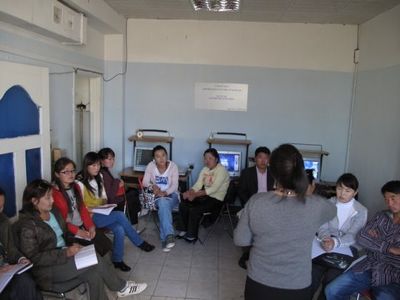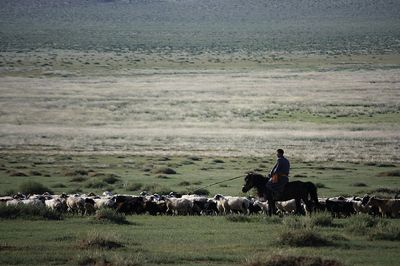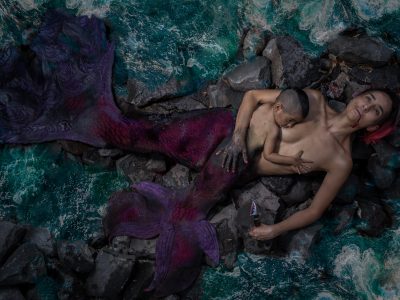Hatry ny fahagola no nilàn'ny fianakaviana mpifindrafindra monina avy any Mongolia tamina toerana midadasika fa izany no mifandrindra amin'ny fomba fiainany. Taloha dia azon'ny biby fiompiny nivalamparana avokoa na ny sakafom-biby na ny rano. Saingy niova avokoa izany rehetra izany, fa nanimba ny fomba fiainan'ireo fianakaviana ireo ny fiovaovan'ny toetr'andro.
Nampivandravandra izany fiovana izany ny lahatsoratr'i Joshua Kucera ao amin'ny Eurasianet :
Global warming is having a harsh effect on Mongolia’s nomadic herders, who comprise about 40 percent of the country’s overall 3 million inhabitants. Since 1940, the mean air temperature in the country has increased 1.6 degrees Celsius. Heat waves are longer, and rain patterns have become “quite variable, decreasing at one site and increasing at a site nearby,” according to an assessment by the country’s Ministry of Nature and the Environment. The Gobi Desert, in the south of the country, is creeping northward.
Mihena ny firaofan'ny biby, izay loharanon-tsakafo manan-danja amin'izy ireo, ahitra noho ny fitomboan'ny tany hain'i Gobi. Miatrika olana eo amin'ny rano fisotro ihany koa ny mponina, araka ny fitantaran'ny mpamaham- bolongana Mandah, nanoratra ny olana atrehin'ny fokonolona amin'ity resaka rano ity:
Mongolian high mountain peak’s snowcap and glaciers have been melting and thinning because of the Global Warming. The thickness of the snow melting will become 131 centimeters by 2039. According to the scientist, the whole world will start to face fresh water shortage by 2020 and 108 million people actually have to deal with the fresh water shortage by 2025. Since 1996, Mongolian groundwater level has been decreasing constantly. Some of the biggest lakes in Gobi region such as: Taatsiin tsagaan, Adgiin tsagaan, Ulaan, Orog lakes as well as many other rivers dried up.
Mameno ny momba io fiovaovan'ny toetr'andro io ny mpamaham- bolongana sady botanista Ariungerel:
Nowadays, the meaning of the phrase “water is treasure” is becoming clearer. Our country is situated far from nearest sea and has less water sources on the ground and underground compared with countries that has enough water sources. Our people range their life in line with water sources, for example: remote area can be utilized only in winter times because running water source is scarce there, only snow is available there. Elders said that they used to use mouthful water to wash their faces and hands, but in the contemporary world, we use many more litters of water for the same reason.
Maro ny lohahevitra tsy mba fantatry ny ao an-toerana loatra, ary manoatra noho izany ny zavatra manerantany. Saingy, misy tetikasa ao an-toerana antsoina hoe Nomad Green (dika manta: Mpifindrafindra monina maitso) nandray andraikitra hampianatra ny fampiasana fitaovana entin'olo-tsotra mampahalala vaovao tahaka ny bolongana, sary ary lahatsary mba ahafahana milaza ny tantaran'ity firenena ity sy ny olana ara-tontolo iainana entiny. Nanomboka tamin'ny taona 2009 sy iarahan'ny fikambanana sy sampan-draharaham-panjakana miasa, ary efa voapetrapetraka ny daty hanaovana atrikasa isan-karazany ao andrenivohitra Ulaanbaatar sy tanàna hafa manodidina an'i Mongolia.
 Sarin'ny atrikasa Nomad Green nataon'i Portnoy (Lehilahy Miasa) ary arovan'ny Creative Commons license.
Sarin'ny atrikasa Nomad Green nataon'i Portnoy (Lehilahy Miasa) ary arovan'ny Creative Commons license.Efa nahitana dingana tsara amin'ny fampianarana ny Mongole amin'ny fampiasana ireo fitaovana entiny mitantara ny fanamby atrehin'ny fireneny eo amin'ny resaka tontolo iainana ny tetikasa. Anisan'ny porofo amin'izany dingana izany dia ireo mpamaham-bolongana roa efa nolazaina teo aloha teo tamin'ity lahatsoratra ity dia i Mandah sy i Ariungerel dia anisan'ny tao anatin'ny tetikasa Nomad Green avokoa, ary manampy ireo ny feon'ireo liana amin'ny ho avin'ny tontolo iainana any Mongolia.







